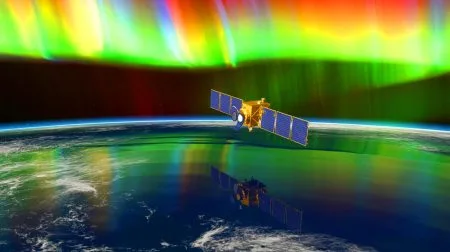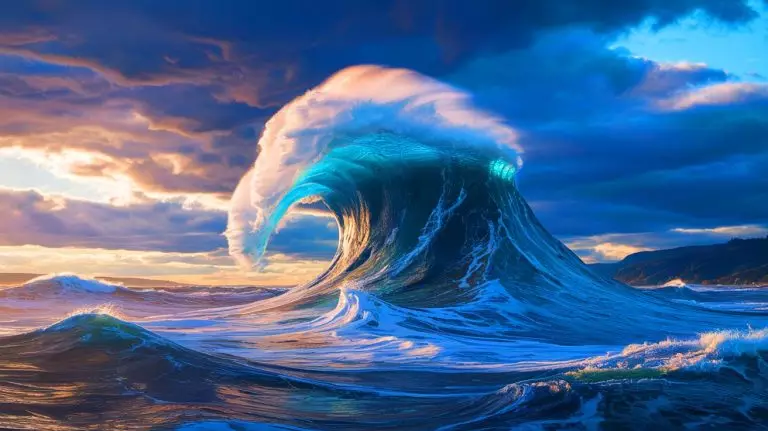| IN A NUTSHELL |
|
The phenomenon of rogue waves has long fascinated scientists and seafarers alike. These gigantic waves, which appear almost out of nowhere, have been the subject of myths and legends, often dismissed as sailor’s tales. However, in November 2020, a rogue wave off the coast of Ucluelet, Vancouver Island, brought this awe-inspiring phenomenon into sharp scientific focus. Detected by a research buoy operated by MarineLabs, this wave soared to a staggering 58 feet, equivalent to a four-story building. This event marked a pivotal moment in oceanographic studies, challenging previous assumptions about the nature and occurrence of rogue waves.
Understanding the Enormity: What Makes Rogue Waves Extraordinary
Rogue waves are defined as waves that are at least twice the height of the surrounding waves. The Ucluelet wave not only met this criterion but exceeded it significantly, being nearly three times larger than its neighbors. This characteristic makes them extremely dangerous and unpredictable. Johannes Gemmrich, a physicist at the University of Victoria, emphasized the significance of this wave, stating that proportionately, it might be the most extreme giant wave ever recorded. These waves are not just anomalies; they are phenomena that can have devastating impacts on vessels and coastal structures.
The unpredictability of rogue waves lies in their sudden appearance, often in the middle of relatively calm seas. While many theories exist regarding their formation, including the interference of wave trains, ocean currents, and wind patterns, no single explanation fully accounts for their occurrence. Scientists continue to study these waves, utilizing data from incidents like the Ucluelet wave to improve predictive models and understand their underlying mechanisms.
From Myth to Scientific Reality
For centuries, tales of enormous waves capable of swallowing ships whole were relegated to the realm of maritime folklore. Without tangible evidence, the existence of rogue waves was largely dismissed by the scientific community. This skepticism persisted until the seminal event of 1995, when the Draupner oil platform, situated approximately 100 miles off the Norwegian coast, was struck by a 85-foot wave. This incident, known as the “Draupner wave,” provided the first concrete evidence of rogue waves, transforming maritime lore into scientific reality.
Since the Draupner wave, the study of rogue waves has gained momentum, with several documented occurrences across the globe, including in inland lakes. These events have fueled advancements in oceanographic technology and methodologies, enabling more accurate measurements and analyses. The transition from myth to science underscores the importance of empirical evidence in understanding and addressing maritime hazards.
The Impact on Maritime Practices and Safety
The realization that rogue waves are not mere myths has profound implications for maritime safety and engineering. Ships and offshore platforms are now being designed and constructed with the potential threat of rogue waves in mind. Engineers and designers are incorporating enhanced structural features to withstand these powerful forces, prioritizing safety and resilience.
Moreover, the knowledge of rogue waves has led to the development of improved forecasting models. Institutions and companies involved in maritime operations are investing in research to better predict when and where these waves might occur, potentially mitigating their impact. While predicting specific rogue waves remains challenging, understanding the conditions conducive to their formation can aid in issuing timely warnings and safeguarding lives and property.
Looking Ahead: The Future of Rogue Wave Research
As technology advances, so does the potential for deeper insights into rogue waves. The use of satellite data, advanced computer simulations, and real-time monitoring systems are paving the way for breakthroughs in this field. Researchers are optimistic that continued study will unravel the mysteries surrounding these waves, leading to more robust predictive models and safety protocols.
The quest to understand rogue waves also holds broader implications for climate science and oceanography. By studying these waves, scientists can glean information about ocean dynamics, weather patterns, and climate change. The intersection of these disciplines offers a holistic view of our planet’s complex systems, fostering collaboration and innovation in addressing global challenges.
The giant wave off Ucluelet serves as a reminder of the ocean’s awe-inspiring power and unpredictability. As we continue to explore and understand these phenomena, we are faced with the question: What other secrets do the world’s oceans hold, waiting to be discovered by the curious minds of tomorrow?
Did you like it? 4.3/5 (21)






Wow, a 58-foot wave! That’s like a four-story building of water. 😲
What’s the difference between a rogue wave and a tsunami?
Isn’t it amazing that the ocean still keeps so many secrets from us?
I wonder if climate change is affecting the frequency of these rogue waves. 🤔
Thanks for the article! It’s both fascinating and a bit scary.
How do they measure waves that are so gigantic? Special equipment?
58 feet?! That’s insane. Makes me rethink my beach vacation plans. 😅
Are rogue waves only dangerous to ships, or can they affect coastal areas too?
How does a wave like this even form? Are there specific conditions that make it more likely?
More evidence that the ocean is the most unpredictable part of our planet. 🌍
How do researchers gather data on something as unpredictable as a rogue wave?
Interesting piece! But how often do these waves actually occur? Anyone know?
This article is a great reminder of the power of nature. Respect the sea! 🌊
Can rogue waves be predicted with certainty, or is it still mostly guesswork?
So this wave was detected by a buoy? Amazing what technology can do these days.
Why wasn’t there any mention of the impact on local wildlife? 🐋
Does anyone else feel like the ocean is a bit more terrifying after reading this?
Great article! Would love to read more about other rogue wave incidents.
Are rogue waves related to other extreme weather events, like hurricanes?
So glad to see rogue waves getting the scientific attention they deserve. 🌊 Kudos to the research team!
The fact that rogue waves were considered folklore for so long is fascinating. Shows how much we have yet to learn!
Is it just me, or does the ocean seem scarier than outer space sometimes? 🤯
Why did it take until 1995 for rogue waves to be taken seriously by scientists?
Can anyone explain why these waves were considered myths for so long?
Interesting read, but could use more detail on how predictive models work. Anyone have more info?
Rogue waves sound terrifying! How do ships prepare for something so unpredictable?
This article just made me more scared of the ocean. 😬
Are there specific regions where rogue waves are more common?
Glad to hear technology is advancing to predict these waves better. Safety first! 🛳️
Does anyone know if there were any ship incidents due to the Ucluelet wave in 2020?